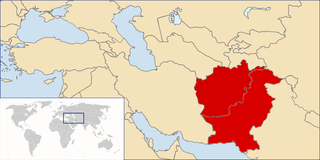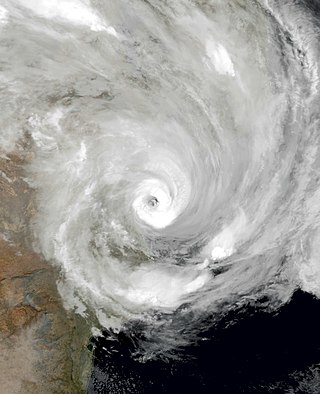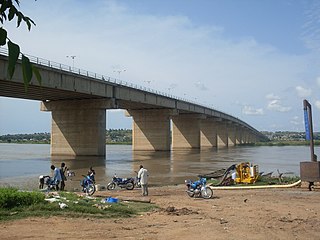
Daikundi is one of the thirty-four provinces of Afghanistan, located in the central part of the country. It has a population of about 516,504 people, who are mostly peasants, traders, and shop owners.

A humanitarian crisis is defined as a singular event or a series of events that are threatening in terms of health, safety or well-being of a community or large group of people. It may be an internal or external conflict and usually occurs throughout a large land area. Local, national and international responses are necessary in such events.

Disaster response refers to the actions taken directly before, during, or immediately after a disaster. The objective is to save lives, ensure health and safety, and meet the subsistence needs of the people affected. It includes warning and evacuation, search and rescue, providing immediate assistance, assessing damage, continuing assistance, and the immediate restoration or construction of infrastructure. An example of this would be building provisional storm drains or diversion dams. Emergency response aims to provide immediate help to keep people alive, improve their health and support their morale. It can involve specific but limited aid, such as helping refugees with transport, temporary shelter, and food. Or it can involve establishing semi-permanent settlements in camps and other locations. It may also involve initial repairs to damage to infrastructure, or diverting it.

Environmental issues in Afghanistan are monitored by the National Environmental Protection Agency (NEPA). They predate the political turmoil of the past few decades. Forests have been depleted by centuries of grazing and farming, practices which have only increased with modern population growth.
Guzargahi Nur or Gozargah-e-Noor is a district in Baghlan province, Afghanistan. It was created in 2005 from part of Khost wa Firing District.

The 1999 Vietnamese floods occurred in late October 1999 when Vietnam experienced the worst flooding in forty years. Tropical Storm No. 9 first appeared in heavy rain from 18 to 20 October, hitting the central provinces of Quang Binh, Quang Tri, Thua Thien Hue, Danang, Quang Nam in Vietnam. The rain was the first in a series of rainstorm events that lasted for two to three weeks.

Acted is a French international solidarity non-governmental organization (NGO), founded in 1993. It is headquartered in Paris.
MERCY Malaysia or Malaysian Medical Relief Society is a non-profit organisation focusing on providing medical relief, sustainable health related development and risk reduction activities for vulnerable communities in both crisis and non-crisis situations. As a non-profit organisation, MERCY Malaysia relies solely on funding and donations from organisations and generous individuals to continue their services to provide humanitarian assistance to beneficiaries, both in Malaysia and internationally. The organisation is a registered society according to the Societies Act 1966 in Malaysia, and the headquarters is in the capital city of Kuala Lumpur.

The floods in Pakistan began in late July 2010, resulting from heavy monsoon rains in the Khyber Pakhtunkhwa, Sindh, Punjab and, Balochistan regions of Pakistan, which affected the Indus River basin. Approximately one-fifth of Pakistan's total land area was affected by floods, with the Khyber Pakhtunkhwa province facing the brunt of the damage and casualties. Nationwide, there were 1,985 deaths. According to Pakistani government data, the floods directly affected about 20 million people, mostly by destruction of property, livelihood and infrastructure.

In August 2013, Pakistan and eastern Afghanistan experienced heavy rain that led to flash flooding. More than 180 died as a result of the floods.

The 2015 Afghanistan avalanches were a series of devastating snow avalanches that occurred in late February 2015 across northeastern Afghanistan, primarily affecting four provinces. The hardest hit was Panjshir Province, where entire villages were buried under the snow. The disaster claimed the lives of up to 308 people, making it one of the deadliest avalanches in Afghanistan's history. The avalanches also impacted Parwan Province, causing widespread destruction and further complicating rescue efforts in the remote, mountainous regions.
In 2016, deadly floods hit Ethiopia, leaving at least 200 people dead and over 200,000 people homeless as seasonal rains come early to the country. The majority of these deaths occurred in the city of Jijiga while elsewhere, heavy downpours of rain were reported with more floods expected in the next few days. The floods are reportedly at higher levels than other flood travesties than that of previous years.

Zimbabwe experienced severe floods from December 2016 through March 2017 due to heavy rains that followed a two-year drought.

In Afghanistan, climate change has led to a temperature increase of 1.8 °C since 1950. This has caused far-reaching impacts on Afghanistan, culminating from overlapping interactions of natural disasters, conflict, agricultural dependency, and severe socio-economic hardship.

2020 Assam floods refers to the significant flood event of the Brahmaputra River in the Indian north-eastern state of Assam and coincided with the COVID-19 pandemic. Initial flooding started in May 2020 due to heavy rainfall affecting 30,000 and destroying crops across 5 districts. As of October 2020 the floods affected over five million people, claiming the lives of 123 people, with an additional 26 deaths due to landslides, 5474 villages were affected and over one hundred and fifty thousand people found refuge in relief camps.
The 2020 Yemen flood was a flash flood that killed at least 172 people in Yemen and damaged homes and UNESCO-listed world heritage sites across the country, officials said.

Tropical Cyclone Eloise was the strongest tropical cyclone to impact the country of Mozambique since Cyclone Kenneth in 2019 and the second of three consecutive tropical cyclones to impact Mozambique in the 2020–21 South-West Indian Ocean cyclone season. The seventh tropical depression, fifth named storm and the second tropical cyclone of the season, Eloise's origins can be traced to a disturbance over the central portion of the South-West Indian Ocean basin which developed into a tropical depression on 16 January, and strengthened into a tropical storm on 17 January, though the storm had limited strength and organization. On the next day, the storm entered a more favorable environment, and it soon intensified to a severe tropical storm on 18 January. Late on 19 January, Eloise made landfall in northern Madagascar as a moderate tropical storm, bringing with it heavy rainfall and flooding. The storm traversed Madagascar and entered the Mozambique Channel in the early hours of 21 January. After moving southwestward across the Mozambique Channel for an additional 2 days, Eloise strengthened into a Category 1-equivalent cyclone, due to low wind shear and high sea surface temperatures. Early on 23 January, Eloise peaked as a Category 2-equivalent tropical cyclone on the Saffir–Simpson scale as the center of the storm began to move ashore in Mozambique. Shortly afterward, Eloise made landfall just north of Beira, Mozambique, before rapidly weakening. Subsequently, Eloise weakened into a remnant low over land on 25 January, dissipating soon afterward.
The 2019–2020 Congo River floods resulted from torrential rains from October 2019 to January 2020 that caused the overflow of the Congo and Ubangi rivers, floods and landslides throughout the Democratic Republic of Congo (DRC) and Republic of Congo (RoC) and led to the displacement of hundreds of thousands of people.

A 4.0-kilometre (2.5 mi) deep earthquake measuring magnitude (Mw ) 6.2 struck southeastern Afghanistan on 22 June 2022 at 01:24:36 AFT. The earthquake had a maximum Modified Mercalli intensity of IX (Violent). There were 1,052–1,163 deaths and 1,627–2,976 injured in Afghanistan and Pakistan. The worst affected provinces in Afghanistan were Paktika, Paktia, Khost and Nangarhar. Casualties and damage also occurred in Pakistan's Khyber Pakhtunkhwa. At least 10,000 homes collapsed or were severely damaged. The earthquake's shallow hypocenter, proximity to populated areas and low building quality contributed to its destructive effects. Shaking was felt over 500 km (310 mi) away by at least 119 million people, including Pakistan's Punjab and parts of India and Iran.

The 2022 Adamawa State flood was a natural disaster that occurred in Adamawa State, Nigeria, in September 2022. It affected over 30,000 square kilometers of land and exposed about 6.6 million people to potential risks. The flood was caused by heavy rainfall and increased water flows from the Cameroonian highlands. It resulted in 25 deaths, 58 injuries, and the displacement of 131,638 people. It also submerged 153 communities and damaged houses, farmlands and other properties. The flood highlighted the vulnerability of the region to such events and the need for better preparedness and mitigation measures.















